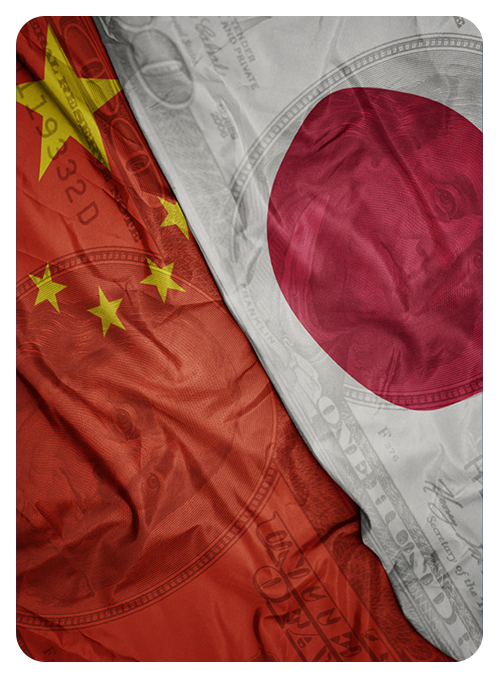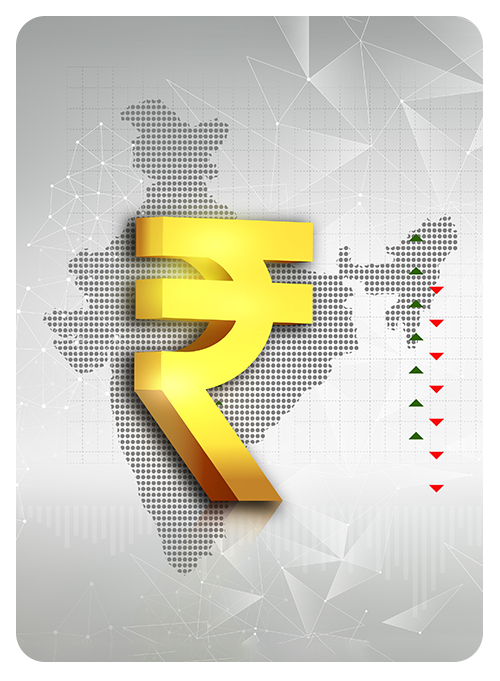Finsphere
Tariffs and Turnarounds:
April Sees Global Sell-Off Followed by Strong Rebound.

Dear Clients and Stakeholders,
April 2025 proved to be a month of stark contrasts in global equity markets, with investor sentiment swinging sharply due to a series of high-impact developments. The month began with heightened anxiety as President Trump implemented sweeping tariffs, including a 10% baseline tariff on all imports and a dramatic 145% tariff on Chinese goods. This move sent shockwaves through global markets, sparking one of the steepest market declines in recent years. European equities also felt the heat, with the STOXX Europe 600 plummeting 8.4% that week - its worst performance in five years.
However, by mid-April, markets rebounded strongly as President Trump reversed course on many of these tariffs, announcing a 90-day pause on reciprocal tariffs for most U.S. trading partners, while keeping 10% baseline tariff. This decision, coupled with the exclusion of several critical sectors such as electronics from tariff hikes, gave markets a much-needed boost. The Nasdaq rallied by 15.5%, from 4th April to 2nd May, followed by the S&P 500 (+12.1%) and the Dow (+7.8%), marking significant gains after the earlier sell-off. Despite the rebound, major U.S. indices remained in negative territory for the year, with the Nasdaq and S&P 500 still down by -6.90% and -3.31% year-to-date, respectively.
Meanwhile, Indian equities stood out as a notable performer. The Nifty 50 index rose by 9.9% from 4th April till 2nd May, driven by a relatively stable domestic macroeconomic environment. This resilience was fueled by a mix of factors, namely shift in monetary policy to accommodative & interest rate cut by RBI, falling inflation and industrial production recovery.
The trade talks between the U.S. and China, along with potential discussions between the U.S. and the European Union, became a focal point of attention in April. While the pause in tariff hikes have alleviated some short-term pressures, the long-term outlook for trade relations remains clouded, with future negotiations expected to shape the economic landscape in the coming months.
United States
Slowing Growth Amid Trade Uncertainty.
April 2025 saw the U.S. economy facing significant turbulence, primarily driven by President Trump’s aggressive tariff policies and their reverberations across key economic indicators. The most significant development was the U.S. GDP contraction of 0.3% in Q1 2025, marking the first decline since Q1 2022. This unexpected downturn followed a solid 2.4% growth in Q4 2024 and was largely attributed to a surge in imports as businesses scrambled to stockpile goods ahead of tariff increases. Consumer spending, a key pillar of U.S. economic activity, also slowed, growing at just 1.8%, the weakest pace since Q2 2023, amid rising uncertainty and cost pressures.
The sharp increase in imports, up 41.3%, overshadowed a modest 1.2% rise in exports. The US budget deficit also grew to more than $1.3 trillion in the period from Oct 2024 till March 2025, the second highest six-month deficit on record. Meanwhile, the federal government’s expenditure also fell by 5.1%, the sharpest decline since Q1 2022, reflecting tightening fiscal conditions as the government adjusts to the broader economic environment.
In terms of employment, the U.S. labor market remained resilient but showed signs of softening. Non-farm payrolls rose by 177,000 in April, surpassing expectations, but a slight uptick in the unemployment rate to 4.2% suggested that the labor market was cooling.

Job growth continued to be concentrated in healthcare (+51,000), transportation and warehousing (+29,000), and financial services (+14,000), though federal government employment saw a decline of 9,000. The housing market showed signs of recovery despite the broader economic slowdown. Pending home sales surged by 6.1% in March, marking the highest monthly gain since December 2023. This was driven by strong demand, particularly in the South and Midwest regions. On the other hand, existing home sales fell by 5.6% in March, reflecting ongoing challenges in affordability and supply. New home sales also posted a solid 7.4% month-over-month increase in March, reaching a seasonally adjusted annual rate of 724,000.
On the inflation front, the U.S. saw a slight easing, with annual inflation falling to 2.4% in March, the lowest level since September 2024. However, core inflation, which excludes volatile food and energy prices, remained sticky at 2.8%, indicating that underlying price pressures remain. Energy prices contributed significantly to the moderation in headline inflation, with gasoline prices falling 9.8% year-on-year.
The U.S. equity markets experienced a volatile month. After the announcement of the tariff hikes on April 2, the S&P 500 and Nasdaq experienced their steepest declines since 2020, with the S&P 500 falling 7.86% in the first week of April. However, as trade tensions showed signs of de-escalation following President Trump’s decision to pause many of the tariff hikes for 90 days, the markets rallied. Looking ahead, the U.S. economy faces continued risks from global trade tensions, inflation, and a cooling labor market. While the resilience in job growth and the housing market provides some support, the slowdown in GDP growth and manufacturing activity, along with the rising budget deficit, signal that the road ahead may be more challenging. The ongoing trade negotiations, particularly with China and the European Union, will be pivotal in shaping the economic landscape in the coming months.

Eurozone & UK
Resilience Amid Rising Trade Tensions.
The Eurozone economy expanded by 1.2% year-on-year in Q1 2025, outpacing expectations of a 1% growth and maintaining the momentum from the previous quarter. However, this growth was not uniform across the region. Germany, Europe’s largest economy, remained in decline, with GDP contracting by 0.2% year-on-year in Q1. In contrast, Spain posted a strong 2.8% expansion, while France and Italy grew by more modest 0.8% and 0.6%, respectively. The divergence in growth rates reflects the uneven impact of global trade tensions and domestic economic policies.
Eurozone inflation held steady at 2.2% in April, slightly above market expectations of 2.1%, while core inflation, which excludes volatile food and energy prices, rose to 2.7%, exceeding the forecast of 2.5%. This uptick was driven by a significant increase in services inflation, which rose to 3.9% compared to 3.5% in March. Meanwhile, energy prices saw a sharper decline, with a 3.5% drop compared to 1.0% in the previous month. On a monthly basis, consumer prices increased by 0.6%, matching March's rise.
Eurozone manufacturing showed slight improvement, with the HCOB Eurozone Manufacturing PMI edging higher to 49.0 in April from 48.6 in March, marking the slowest pace of contraction in factory activity in over two years. Despite this, new orders continued to decline, reflecting weak demand, particularly in export orders, exacerbated by the appreciation of the euro and concerns over global trade. On the industrial production front, the region saw a 1.2% year-on-year growth in February, marking the first annual increase in 22 months.
In the UK, April brought mixed signals, with the economy showing some signs of stagnation. The UK's GDP grew by 1.1% in 2024, the strongest growth since 2022, but the outlook for 2025 remains cautious. In March, inflation eased to 2.6% from 2.8% in February, supported by a decline in transport costs, particularly due to a fall in motor fuel prices. However, core inflation remained relatively high at 3.4%, reflecting continued price pressures in non-food sectors such as clothing and footwear.
The labor market remained stable, with the unemployment rate holding steady at 4.4%. Employment increased by 206,000, reaching a record high of 34 million, largely driven by a rise in full-time employment. However, the services sector showed signs of stress, as the UK Services PMI fell to 48.9 in April from 52.5 in March, signaling a contraction in business activity. This downturn was partly attributed to weaker domestic demand and ongoing global economic uncertainty.
Looking ahead, both the Eurozone and the UK face uncertain economic prospects. The European Central Bank (ECB) has maintained a cautious stance, cutting interest rates to 2.25% in April in response to ongoing global trade concerns. While the ECB anticipates modest growth recovery, the risks of further trade disruptions, particularly from U.S. tariffs on European exports, remain significant. In the UK, the economic environment remains challenging, with the government facing pressure to manage domestic fiscal policies amid external trade uncertainties. While inflationary pressures are easing, growth concerns persist, particularly in manufacturing.
Asia
Rising Trade Tensions and Divergent Economic Paths in Japan and China.
Among the tariff turbulence, Japan and China, displayed contrasting economic performance, with Japan facing persistent inflationary pressures and industrial contraction, while China’s robust industrial output and retail growth offered a brighter outlook for the region.
Japan's economy showed signs of weakness in month, with industrial production contracting 1.1% month-over-month in March, following a 2.3% increase in February. This marked the second decline in the first quarter of 2025, signaling that the country’s export-oriented economy remains under pressure, exacerbated by tariff threats and slowing global demand. Year-on-year, industrial output dropped by 0.3%, marking the first annual decline this year.
Japan’s inflation rate eased slightly to 3.6% in March, down from 3.7% in February. This decline was largely due to moderating food prices and energy costs.

However, the core inflation rate remained elevated at 3.2%, signaling persistent price pressures, particularly in clothing, transport, and healthcare. While the Bank of Japan (BoJ) has maintained its key interest rate at 0.5%, the persistent inflationary pressure coupled with weak industrial output paints a challenging picture for the country’s economy.
In contrast to Japan, China’s economy displayed stronger momentum in April. China’s industrial production grew by 7.7% year-on-year in March, significantly exceeding market expectations of 5.6% growth. This surge, the highest since June 2021, was driven by broad-based growth across sectors, with manufacturing expanding by 7.9%, electricity production rising by 3.5%, and mining jumping by 9.3%. Notably, the automotive sector saw impressive growth, with car production rising by 11.5% year-on-year. Retail sales also performed well, increasing by 5.9% year-on-year in March, bolstered by the Spring Festival boost. This strong consumer demand reflects the resilience of domestic consumption, even as the global trade environment remains uncertain. Adding on to this momentum, China’s Q1 GDP growth came in at 5.4%, surpassing consensus expectations. On the monetary front, China’s central bank kept its benchmark lending rates unchanged in April for the sixth consecutive month. The one-year loan prime rate (LPR) remained at 3.1%, while the five-year LPR stayed at 3.6%.
Looking forward, Asia’s economic trajectory remains tied to the unfolding global trade dynamics, with both Japan and China grappling with external risks. Japan's industrial sector is particularly vulnerable to shifts in global demand, while inflationary pressures may continue to dampen consumer sentiment. On the other hand, China's strong industrial growth and resilient retail sales suggest that the country may be better positioned to weather the storm, though the trade war with the U.S. remains a critical risk.

India’s Economic Pulse:
Navigating Global Headwinds with Domestic Resilience.
In April 2025, India’s economy continued to demonstrate resilience amid global trade tensions and external uncertainties. Although the IMF revised India's GDP growth forecast down to 6.2% for FY 2025, reflecting the broader global slowdown, the RBI remains more optimistic with a growth forecast of 6.5%, driven by strong domestic consumption and proactive fiscal measures.
Inflation in India showed signs of moderation in March 2025, with the Consumer Price Index (CPI) falling to 3.3%, down from 3.8% in February 2025. This decline was driven by a sharp reduction in food inflation, particularly vegetables, and the moderation in global oil prices. However, core inflation, excluding food and energy prices, remained heightened at 4.1%, reflecting continued pressures in sectors like housing, healthcare, and education. The Reserve Bank of India (RBI) further reduced the repo rate by 25 basis points to 6.0% in April 2025, while shifting to an accommodative monetary policy stance designed to stimulate demand and support economic momentum, particularly in light of global trade tensions.
India’s industrial production showed a healthy increase of 3.6% year-on-year in March 2025, with manufacturing leading the way, growing at 5.2%. The Purchasing Managers' Index (PMI) for manufacturing stood at 57.2, signaling continued expansion in the sector, well above the neutral 50 mark. Key industries such as chemicals, textiles, and automobiles experienced strong demand both domestically and from key export markets. However, the export-driven sectors, particularly engineering goods and textiles, were somewhat affected by the ongoing global trade disruptions, with export growth slowing to 4.5% in March 2025 from 7.5% in February.
India’s economy is expected to maintain moderate growth in the face of external risks, with 6.2% to 6.5% growth projected for FY 2025, however, cautious optimism is the sentiment for the months to come.
Conclusion
As April concludes, the global landscape remains defined by trade uncertainties, with ongoing tariff negotiations between the U.S., China, and other key economies. While recent tariff pauses have provided temporary relief, the final outcomes of these talks will be pivotal in shaping the economic trajectory for the remainder of 2025. As the ongoing earnings season progresses, we expect clearer insights into corporate resilience, particularly with respect to shifting global demand. As we move through the coming months, we will closely monitor these developments, ensuring that our strategies remain agile in response to both risks and emerging opportunities.
At Chola Securities, we are committed to providing you with strategic insights and a forward-looking approach as we navigate these challenging times. Our focus is to align your investments with emerging opportunities while maintaining a disciplined approach to risk management.
We sincerely value your trust and continued partnership. As we look ahead, we remain committed to adapting to the ever-evolving market landscape, ensuring that your investments are positioned for sustained growth and success.
Warm Regards,
Mr. Senthilkumar Naidu
Chief Business Officer, CSec
